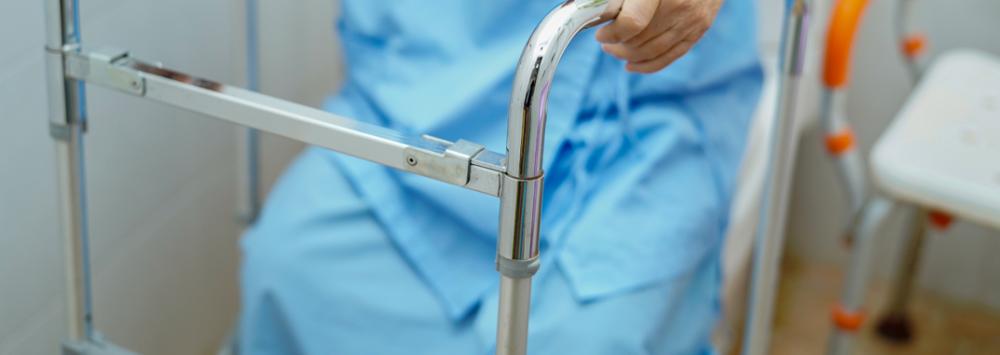
Challenges of Impaired Mobility in the Bathroom and Ways to Overcome Them
Sally Madeley-Carr, OT24 Sep 2020
The physical restrictions old age may throw at us can be daunting, but it's important to realise that there is equipment available to help. Lots of age-related conditions lead to symptoms like reduced balance or strength in various parts of the body, making some everyday tasks more tricky.
In other blog posts we've mentioned how these problems may arise in the bedroom when getting dressed, but in the bathroom there are another set of practicalities to consider.
Reaching difficult parts of the body in the bath or shower
Stiffness or a loss of flexibility through the back, hips and waist is a common issue for many people. This can make it difficult to stretch down to one's toes for example. This may in turn may create issues surrounding putting on socks and shoes, for instance, and it may also restrict your ability to reach the extremities of the body for washing.
Long handled scrubbers and sponges really come into their own if you're in this situation. They help reach your feet, over your shoulders, the back of your head and almost any other part of the body you might have trouble reaching.
Essential Aids supplies a number of this type of grooming tool, some with special features. The 'Easy Reach Lotion Applicator' for example has an innovative design which allows you to 'load' liquid soap or lotion in the head.
As you press the sponge head to the skin, it releases the lotion, allowing effective washing without having to stretch too far with a bar of soap!
Another practical tool is the 'Long Handle Toe Washer'. This has a 24 inch shaft, wide hand-grip and towelling component which enables you to clean between your toes without needing to bend down. The towelling part can be replaced if it gets worn.
Long handles scrubbers sometimes have flexible shafts which can be bent into the perfect shape for your needs.
As the name suggests, it has a scrubber made from real sheepskin, along with a bendable shaft, 24 inches in length. Its oversized grip is designed to make it easier to control for those who have difficulty with narrow handles because of a tremor or arthritic pain in the hands.
Long handled combs and hair brushes are also popular choices in the Essential Aids range. They are great for people who have restricted mobility in the arms and shoulders and have difficulty reaching up to their hair.
Other bathroom tools
Other items from Essential Aids for those who struggle to reach their feet, are foot scrubbers which fix to the floor of the shower. Usually they have sucker cups on the underside and an upturned scrubbing brush for the soles of the feet.
Some versions, like the 'Foot Cleaner With Pumice', have an integral pumice stone alongside the brush bristles.
Long reach toenail clippers are another popular grooming aid for the elderly. As with other long handled tools, they reduce the need to stretch in order to reach the body's extremities.
For people with arthritis in their hands and fingers, tasks which require pressure with the grip on narrow objects may be uncomfortable. Using a toothbrush is one such daily job which can be painful. Some may find it less so if the handle of the toothbrush can be 'built up' to make it larger.
This can be done via some special foam tubing available at Essential Aids, or by wrapping tape around the brush, increasing the girth of the handle. The resulting expanded diameter is usually less painful to hold and can be easier to control for those with a hand tremor.
Similar methods are used to improve the comfort and control of cutlery in the kitchen.
The 'Tube Master' is another simple but clever bathroom tool which allows the user to squeeze a toothpaste tube with minimal effort. Like building up handles of toothbrushes, it's great for those with arthritis in the hands who might find it uncomfortable exerting pressure through the fingers.
Using the toilet
People who are unsteady on their feet may benefit from a support rail fitted next to the pedestal. A rail may also help if getting up and down from a sitting position is difficult. Bad backs and a host of other conditions can lead to this particular task becoming challenging.
While not necessarily exclusively a toilet aid for elderly people, a toilet frame is a well established piece of bathroom mobility equipment.
If you're unfamiliar with these, they provide a 'box-like' support frame which sits around the toilet pedestal. Typically made of aluminium, they offer two near-horizontal support bars on each side which can be used to lower yourself onto the toilet seat and back up to a standing position afterwards.
Fixing a toilet frame to the floor may offer added stability, but most modern units are now freestanding. Some, like the 'Foldeasy Toilet Frame', have flip-down foot-plates on which you rest your feet as you sit down and stand up. This increases the stability of the toilet frame as you lean on its arms.
This particular model has the advantage of folding up neatly after use.
Sometimes referred to as toilet surrounds, most models are adjustable so they can be set at the most useful and supportive height. Some also adjust in width - useful for larger or even bariatric individuals.
Using a raised toilet seat is another option if you have difficulty lowering or raising yourself from the pedestal. The idea here is similar to booster cushions for armchairs - to increase the overall height of the toilet seat, reducing the user's distance of movement from standing to sitting, and visa versa.
Different heights are available, as well as various clamping mechanisms, so you should be able to find one to suit your own toilet. Some models are open while others have an integral folding lid, similar to that of a standard toilet.
Part of Essential Aids range features toilet frames come with built-in raised toilet seats. These models are useful for those who don't want to directly fix a raised seat to the existing toilet.
A useful toilet aid for elderly people who might have difficulty reaching the loo in the middle of the night is the portable urinal bottle. These come with secure caps and wide openings, designed for ease of use and to reduce spillages.
Using the bath
Using the bath itself can prove challenging in later life. Climbing over the bath side, sitting down on the bathtub's floor and back again may be difficult. While substantial pieces of kit like bath-lifts might be worth considering, there are simpler aids which may also help.
Bath seats which sit inside the bathtub are one such option. Similarly to a raised toilet seat, these work by increasing the height of the sitting level, meaning less distance of travel for the user. Most models fix to the floor by means of strong suction cups.
Bathroom aids like this are particularly useful when used in combination with others. A bath seat for instance works well with accompanying fitted grab rails. Rails fitted to the wall may work well, as may upside-down 'U-shaped' bathrails. These usually fit to the bath-side and project upwards.
Bath steps which make it easier to climb into the bath are another type of aid to consider if you find it challenging getting in and out.
Using the shower
The shower cubicle has one big advantage over a bath in that there's no barrier to climb over to use it. For this reason, many elderly people choose showering over bathing.
Still, some may find it difficult to stand up comfortably for the duration of a shower. While a grab rail fitted within the cubicle may help with one's stability, it may help to consider seating options too.
Essential Aids supplies a range of shower stools and chairs designed specifically for use within the shower.
Depending on the size of the cubicle's floor, there are several styles which may be suitable. If space is an issue, a three-legged stool might be the best option, while chairs with four legs offer the greatest stability.
Seats which fold up against the wall are popular too, as they clear the space for other users who may not require their use. Obviously it's important that they are fitted by a qualified professional who understands the wall material and the correct fixings to use.
Some fold-down shower seats have legs which flip down, offering more support to the seat itself. These models tend to have much greater weight bearing qualities, so are ideal for heavier individuals.
Many elderly people are unsteady on their feet and shower trays may well be slippery. If this is the case, a rubber or plastic compound shower mat may be worth considering. They usually stick to the floor of the tray via suckers and have a high friction top surface which remains grippy even when wet.
The ideas mentioned here are some of the fundamental tools which can help people remain independent in their bathrooms even if they are dealing with health conditions which compromise their strength or balance.

Sally Madeley-Carr, OT
Sally qualified as an Occupational Therapist in 1996 and is a well-respected professional in the field of rehabilitation equipment and living aids. She has worked in private practice and within the NHS, developing a broad experience with adults and children. Click here for Sally's registration with the Health and Care Professions Council. The HCPC regulates health, psychological and social work professionals in the UK.